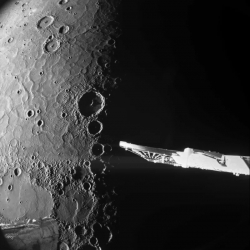

The hadal zone, the deepest part of the ocean, is a world of extreme conditions: complete darkness, crushing pressure, and scarce food.
Yet, life thrives here, and scientists are constantly uncovering remarkable new species adapted to this harsh environment.
One of the latest discoveries is a fast-swimming predatory crustacean, Dulcibella camanchaca, found in the Atacama Trench.
This discovery was made by researchers from the Woods Hole Oceanographic Institution (WHOI) and the Instituto Milenio de Oceanografía (IMO) at the Universidad de Concepción in Chile.
Their findings, recently published in Systematics and Biodiversity, highlight the incredible biodiversity in one of the Earth’s least explored ecosystems.
Meet Dulcibella camanchaca
At nearly 4 centimeters long, Dulcibella camanchaca is a large amphipod, a type of crustacean, and the first known active predator of its kind at such depths.
It uses its specialized appendages, known as raptorial arms, to hunt smaller amphipods in the deep, food-scarce waters of the Atacama Trench.
The species was named “camanchaca” after a word meaning “darkness” in the languages of the Andean peoples, reflecting the deep, dark habitat it calls home. The trench lies over 8,000 meters below the surface in the eastern South Pacific Ocean, off the coast of northern Chile.
“The discovery of Dulcibella camanchaca shows how life in the deep ocean has evolved to survive in one of the most extreme environments on the planet,” explained Dr. Johanna Weston, a hadal ecologist at WHOI and co-lead author of the study.
A hotspot for unique species
The Atacama Trench is known for its distinctive ecosystem.
Located beneath productive surface waters and isolated from other deep-sea environments, it is home to many species found nowhere else.
What’s even more remarkable about Dulcibella camanchaca is that it represents not only a new species but also a new genus, further emphasizing the trench’s status as a biodiversity hotspot.
The discovery was made during the 2023 Integrated Deep-Ocean Observing System (IDOOS) Expedition aboard the research vessel R/V Abate Molina. Scientists used a lander vehicle—a specially designed untethered platform—to reach a depth of 7,902 meters, where they collected four specimens of the new crustacean. The samples were frozen and later analyzed at the Universidad de Concepción, where both DNA and detailed physical studies confirmed the species’ uniqueness.
The importance of deep-sea exploration
“This collaborative effort confirms Dulcibella camanchaca as a new species and highlights the importance of exploring the Atacama Trench, which is essentially Chile’s front yard,” said Dr. Carolina González, co-lead author and expert in sample collection and genetic analysis.
As technology advances, scientists expect to discover even more species, each offering a glimpse into the unique adaptations needed to survive in the deep ocean. Such studies not only enhance our understanding of deep-sea ecosystems but also provide critical information to protect these fragile environments from threats like pollution and climate change.
The discovery of Dulcibella camanchaca is a reminder of the wonders still hidden in the ocean’s depths, waiting to be explored. Scientists are optimistic that more groundbreaking discoveries lie ahead.
Source: KSR.







Leave a Comment